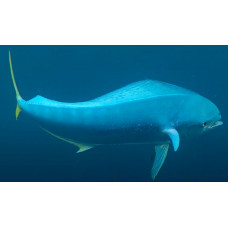Latin name
Coryphaena hippurus
Other names
Сommon dolphinfish, dorado, pompano.
Identification
The name "Coryphaena" is derived from the Greek κορυφή - head, and the species name from the Latin hippurus - goldfish. The body is elongated and flattened at the sides, reaching its maximum height at the occiput and gradually tapering to the tail, which is covered with fine cycloid scales. The head is large, compressed at the sides, with a rounded profile. The mouth is wide and the teeth are set back. The teeth are conical, small and sharp. Some of these teeth are on the palate and even on the tongue. The forehead is steep, almost vertical in males. During the spawning season, males grow a bony ridge on the forehead. The dorsal fin is very long with 56-58 soft rays from the head to the caudal peduncle. The anal fin, with 25-26 soft rays, begins at the centre of the body and extends to the caudal peduncle. The pectoral fin has 15 soft rays. Above the pectoral fin is a curved lateral line. The pelvic fins are long, with a barb and 5 soft rays. The caudal fin is crescent-shaped, with narrow, long blades. There are 200-320 scales on the lateral line. Swim bladder absent. Vertebrae 30-34. Can reach a speed of 70 km/h and is one of the ten fastest fish in the world.
Fish colouring
The coloration is very bright. The back is bluish-green with a metallic sheen. The body is greenish-golden, shimmering with different colours of the rainbow. The dorsal fin is dark green to dark blue. The rest of the fins are yellow or orange. When the fish is taken out of the water, its body shimmers with all the colours of the rainbow, it will change colour several times and after death it will fade quickly.
Distribution
Inhabits tropical and subtropical waters of the Indian, Pacific and Atlantic Oceans. In warm seasons it can be found in temperate waters. For example, in summer it has been found in the Sea of Japan, the Strait of Tartar, the southern Kuril Islands and the Sea of Okhotsk.
Habitat
Marine, oceanodromous, pelagic fish. Widespread in tropical and subtropical waters of the world ocean. Lives in near-surface waters to depths of 100 metres. Often follows algae floating on the surface, constantly migrating.
Size
Maximum length 210 cm (usually up to 1 m) and weight up to 40 kg. Maximum life expectancy is 4 years, usually no more than 3 years.
Life history and Behavior
It makes long seasonal migrations, moving to higher latitudes during the warm season.
Food and feeding habits
It is a predator: it feeds on smaller fish, squid, crabs, zooplankton. Flying fish form the basis of its diet. Young fish hunt as part of a pack, but as they get older the number of individuals in the pack decreases. Adult fish are solitary.
Reproduction
In the Gulf of Mexico they first mature at 3-4 months, in the Caribbean and off northeastern Brazil at 4 months, and in the North Atlantic at 6-7 months. Males mature at a greater length than females; first maturing males range from 40 to 91 cm and females from 35 to 84 cm. Spawning occurs throughout the year. Spawning is batch spawning. Fecundity ranges from 240,000 to 3 million eggs.
Fishing
Valuable commercial fish. The meat has a pleasant flavour and is very popular with gourmets.
| Classification | |
| Phylum | Chordata |
| Class | Actinopterygii |
| Squad | Carangiformes |
| Family | Coryphaenidae |
| Genus | Coryphaena |
| Species | C. hippurus |
| Features | |
| Conservation status | Least Concern |
| Habitat | Pelagic |
| Life span, years | 4 |
| Maximum body weight, kg | 40 |
| Maximum length, cm | 210 |
| Sailing speed, m/s | 19,44 |
| Threat to people | Edible |
| Way of eating | Predator |
Mahi-mahi
Tags: mahi mahi


